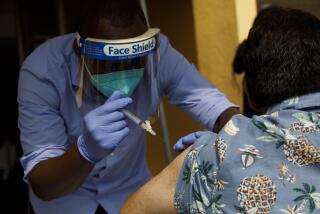H1N1 vaccine was unevenly distributed across L.A. County, figures show
- Share via
Officials have distributed the H1N1 flu vaccine unevenly throughout Los Angeles County, with fewer doses going to medically underserved areas in the county’s north and south, according to public health agency figures.
While there is now a surplus of vaccine countywide, northern and southern areas received a smaller share of the roughly 3 million vaccine doses distributed by the county, mainly because they are home to fewer doctors, pharmacies and other health providers, experts said. The lower number of healthcare providers translates into a lower number of requests for the vaccine, they said.
Los Angeles County public health officials said they attempted to distribute the vaccine fairly, especially during a national shortage in November and December, but they acknowledged that some of those efforts failed to ensure equal access.
“To some degree, the disparity on the private side is a reflection of the disparity in healthcare,” said Jonathan Freedman, the county Public Health Department’s chief deputy director
Antelope Valley received about 2% of the H1N1 vaccine that the county supplied to healthcare providers from Sept. 1 to Jan. 8, the most recent figures available. That was about one dose for every five people, compared with the county average of one for every three people, figures show.
In the South area of the county, which includes South Los Angeles, providers received 7% of the county H1N1 flu vaccine supply -- about one dose for every five people.
The Antelope Valley and South areas are considered medically underserved because they are home to large numbers of uninsured and low-income residents, Freedman said.
By contrast, other areas of the county received a greater share and more doses per person.
In the East area, providers received about 11% of the county vaccine supply, enough for one in four people.
The South Bay received about 15% of the county supply and the San Gabriel area about 18%. The San Fernando area received roughly 21%.
The Metro area, which includes downtown Los Angeles, home to a number of community clinics and other providers, received about 15% of the county supply. Those areas were on par with the county average: about one vaccine dose for every three people.
The West area, which includes Beverly Hills, Santa Monica and Malibu, received 11% of the county supply, enough for more than half the population.
The H1N1 vaccine was provided by the federal government to the states for free.
California received its share based on population. Under an agreement with the state, Kaiser Permanente received 15% of the total.
The rest went to local public health departments for distribution to clinics, hospitals, correctional facilities and private providers who requested it.
Unlike most areas of the county, which received the vaccine exclusively from the county Public Health Department, providers in San Gabriel and South Bay also received it from public health departments in Long Beach and Pasadena and directly from the state.
Public health officials said they tried to offset the lack of private providers in some areas by withholding about 20% of the vaccine supply they received, about the same percentage of the county’s population that is uninsured.
Those doses were used to mount temporary vaccination clinics in underserved areas. Clinic staff vaccinated about 204,000 people, figures show.
But Freedman admitted that local attendance at the vaccination clinics in the south and other areas was lower than expected.
“We didn’t have as promising attendance there as we wanted, but we put the supply there,” Freedman said. “We tried to make up for the lack of private providers.”
Healthcare providers in the Antelope Valley, an underserved area, insisted that demand was strong.
At the High Desert Medical Group in Lancaster, stocks of H1N1 vaccine were running short in early January, said Jane Frye, a registered nurse and clinical administrator in the office.
The office had ordered 2,500 doses of the vaccine and saw steady demand among its 400 to 500 daily patients, Frye said.
“We give it to patients every day here,” she said. “People wanted it.”
Others faulted public health officials for not doing more to ensure that needy communities received more vaccine.
“Their position is they did the best they could,” said Supervisor Mark Ridley-Thomas, who represents South Los Angeles. “My position is that’s not enough.”
Ridley-Thomas said he has been fielding complaints from community advocates in his district who say that public health officials failed to offset the lack of vaccine among private providers.
“In a more affluent community, you’re going to have more pharmacies and doctors’ offices and they’re going to be more aggressive in trying to get the vaccine for themselves and their families,” said Bill Hobson, president and chief executive of Watts Healthcare Corp. “Those are issues they have to tackle.”
Hobson said he was especially concerned because studies show that African Americans and Latinos are at greater risk of contracting H1N1 and being hospitalized.
He is attempting to win a county contract for H1N1 vaccine outreach to African Americans in coming months, part of a $1-million effort by the county to vaccinate more minorities.
Supervisor Gloria Molina said it was supervisors’ responsibility to ensure the vaccine was fairly distributed in their districts.
She conceded that in the South area, a lack of private providers hampered vaccine distribution.
She said supervisors have dedicated millions to improve and expand public and private clinics in underserved areas during the last year, but more needs to be done.
“That is an underlying problem,” she said. “If there isn’t a provider, you can’t deliver a shot.”
molly.hennessy-fiske @latimes.com
More to Read
Sign up for Essential California
The most important California stories and recommendations in your inbox every morning.
You may occasionally receive promotional content from the Los Angeles Times.











